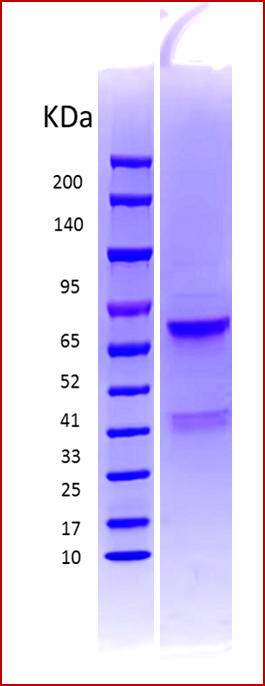- 产品描述
- 产品数据
-
- 商品名称: Recombinant R-Spondin 2
- 商品编号: RP8060
- 物种: Human
- 表达系统: HEK293
- 标签: Human IgG1 FC
- 纯度: >95%
- 活性: 细胞活性
产品描述(DESCRIPTION)
Source
Human embryonic kidney 293 cells, HEK293
Gln22-Gly205, with a FC tag at the C-terminal
NP_848660.2Species
Human
质量属性(SPECIFICATIONS)
SDSPAGE
The protein migrates as 70 KDa under reducing (R) condition (SDS-PAGE) .
Purity
>95% as determined by SDS-PAGE.
Formulation
Lyophilized from 0.22 μm filtered solution in PBS, pH7.4, 5% trehalose and
0.01% Tween 80 were added as protectant before lyophilization保存与使用(PREPARATION AND STORAGE)
Shipping
The product is shipped with dry ice.
Reconstitution
Reconstitute at 100 μg/mL in sterile PBS containing at least 0.1% human or bovine serum albumin.
Storage
For long term storage, the product should be stored at lyophilized state at -20°C,avoid repeated freezethaw cycles.
Stability
>12 months, under -20°C conditions before reconstitution.
>6 months, -80 °C under sterile conditions after reconstitution.背景介绍(BACKGROUND)
Roof plate-specific Spondin 2 isoform 1 (R‑Spondin 2, RSPO2), also known as cysteine‑rich and single thrombospondin domain containing protein 2 (Cristin 2), is a 33 kDa secreted protein that belongs to the R-Spondin family (1‑3). The four R‑Spondins regulate Wnt/ beta -catenin signaling and overlap in expression and function (1‑3). Like other R‑Spondins, RSPO2 contains two adjacent cysteine‑rich furin-like domains (aa 90‑134) followed by a thrombospondin (TSP-1) motif (aa 144‑204) and a C-terminal region rich in basic residues (aa 207‑243). The basic region binds heparin and mediates cell surface retention and extracellular matrix attachment while the furin‑like domains are required for Wnt/ beta -catenin signaling (1, 3, 4). RSPO2 contains one potential N‑glycosylation site. Mature human RSPO2 shares 97‑98% aa identity with mouse, rat, equine, canine and bovine RSPO2 and ~40% aa identity with RSPO1, RSPO3 and RSPO4. Of the three reported splice isoforms of human R‑Spondin 2, isoform 2 lacks residues 1 ‑ 67 of isoform 1, while isoform 3 has a glycine substitution for residues 32‑95 of isoform 1 (5). Human RSPO2 is expressed in organs of endodermal origin in adults, including intestine and lung, and is down‑regulated in tumors of these tissues (1). In the embryonic mouse, RSPO2 expression is concentrated in the apical epidermal ridge, hippocampus, and developing muscle, teeth and bones (1, 6). Deletion of RSPO2 results in down‑regulation of Wnt activity in these areas, malformations of the facial skeleton and limbs, and respiratory failure at birth (7‑9). RSPO2 is an extracellular potentiator of Wnt/ beta -catenin signaling (3, 4). It functions at least in part by binding LRP‑6, stimulating its long-term phosphorylation and down‑regulating its internalization (3, 4). RSPO proteins, especially RSPO2 and RSPO3, also antagonize DKK1 activity by interfering with DKK1‑mediated LRP‑6 and Kremen association (10)
-

4%-20% SDS-PAGE Result Recombinant R-Spondin-2, 2ug reducing
上一页

